How To Pickle Paint And Mix Paint
Stride into any furniture store and chances are y'all volition see a pickled finish on at least one detail. You might spot it on a bed, dresser, table, desk, and even cabinet. A pickled finish is one of the methods article of furniture makers employ to "antique" their projects, and it is quite a popular technique.
In the simplest terms, pickling is a finishing technique that whitens forest. Although you lot can find pickling stains sold in most hardware stores, technically pickling is a method and non a stop. I'll explicate more almost the method below.
Many sources merits that oak and ash are the most common woods pickled; some even merits these are the only two wood you can pickle – not true! Yous could pickle any wood, even so you would probably accept better results staying with lighter colored wood. For my project, I used pino.
You lot tin can buy a pickling stain or you tin make your own. Let's talk nearly how to brand your ain.
Here'due south What You'll Need
- Sandpaper (150 – 220 grit)
-
1 quart of white paint (less if your projection is considerably smaller than my pantry)
-
1 quart of water
-
Mixing can (I just used the paint can)
-
Paint brush(es)
-
A cloth (soft and clean is all-time)
-
Varnish / polyurethane
-
Night dye or stain (optional)
Y'all can use oil or latex paint. The material list above is geared toward latex (i.e., h2o-based) since that is the type of pigment I had leftover from a previous project. If you lot choose oil, you'll need nigh a loving cup of paint thinner instead of water. Everything else is the same.
There is some debate as to whether you lot should use primer or regular paint. Some merits primer works best because primers have better coverage and come up in boring, apartment finishes that won't add together any polish to the woods surface. I tried both regular paint and primer and noticed no credible difference. If you simply have regular paint, and you are concerned about the smoothen, just use a flat paint instead of glossy.
Here's How to Create an Amazing Pickled Finish, Step by Step
1) Prep the wood.
The general dominion when finishing woods is that if you tin see a blemish before yous use the cease, the blotch will be magnified past the finish. Make sure y'all take the time to sand your project well. Smooth out any sharp edges or corners. For the pantry, the plywood needed extra sanding because of unsightly pits in the wood.
In one case the project has been sanded, clean off as much sawdust equally yous can.
Optional Footstep: Wet the wood.
Depending on the species of wood you lot employ, and its grain patterns, y'all may want to wipe down the unabridged projection with a wet sponge. Allow the wood to dry, then sand with about 150 grit sandpaper. The water raises the wood fibers before you apply the stain, which can even so exist sanded smooth without removing any stain. Otherwise, the liquid in the stain could raise the grain.
I tested the woods on my project beforehand and found that wetting the unabridged pantry wasn't necessary. The plywood and pine boards simply did not have any noticeable grain enhance.
2) Make the Stain
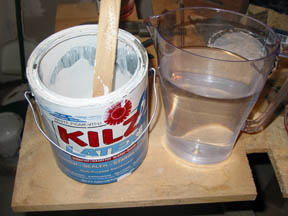
Mix water with latex-based pigment to create the stain.
This next step is not scientific discipline. I had about a quart of paint leftover in a gallon can. I started by calculation 1 loving cup of water so concluded up pouring in about two cups of water total.
Mix the water with the paint. The amount of water you add isn't too important because yous will be wiping away most of the paint anyway. Just brand sure it is thinner than the original paint but not as runny equally straight water.
One affair that is important is to mix enough stain to provide coverage for the entire project. Otherwise, if you have to remix the stain, you might have one solution brighter than the other, and that wouldn't await expert. Or, if you desire to brand pickling a science, only retrieve the exact portions of paint and water y'all mixed. Then repeat the portions.
3) Wipe On the Stain.
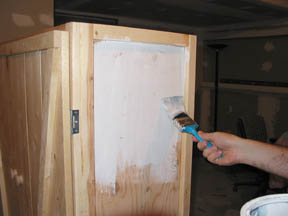
Apply a generous coat of stain.
Use a castor since it's easier to reach into corners than but using a rag. Apply a thick coat of the stain on a manageable area – non so much that information technology completely dries before you lot can wipe information technology downward with a rag.
At this stage, it's non important to worry much about wiping the stain in the direction of the grain, unless of grade you allow the stain to dry out earlier wiping information technology down. More than on that later.
4) Wipe Off Backlog Stain.
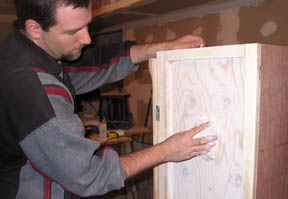
Use a rag to wipe off backlog stain.
Before the stain dries completely, employ a clammy rag to wipe away the stain. Depending on how hard you press, y'all can wipe off almost all of the stain or go out most on. Information technology's mostly preference. Just make certain you lot continue the surfaces of the forest the aforementioned consistency of whiteness.
At this point, I similar to wipe the stain in the direction of the woods grain. Notwithstanding, don't stress too much over this because the rag smooths out well-nigh noticeable strokes.
Tip: It's a good idea to use some leftover bit wood to test the end. This will give you a good idea as to how well the wood accepts the stain. I found that the pino boards did not absorb every bit much as the plywood, which helped me gauge the corporeality needed for each surface blazon.
5) Repeat Steps 3 and 4
Calculation some other coat will issue in a whiter, less transparent look. For the pantry, I applied 3 coats of stain because it matched the dinning room better than having only one-2 coats. Besides, by applying 3 coats I was able to match the plywood with the pine boards perfectly.
6) Apply Varnish
Varnish is of import because your pickling finish is basically a wash, which can be, well, washed off. Not easily, but information technology tin happen, particularly if yous might use any cleaners or other chemical products on your project. To protect against the finish washing off, apply a coat of non-yellowing varnish.
If you decide to follow Pace vii, it'south a good idea to apply a coat of varnish to the project now. Information technology will help forbid confronting any possible muddying up that may occur between the pickling stain and the accent stain. Some people suggest using a spray-on varnish, which I used simply did non detect necessary because the pickling had completely dried and does not launder off very easily.
If you don't follow Step vii, merely wipe on a glaze of varnish. I used my favorite varnish, Kel-Thane. It is very important to piece of work the varnish in the management of the wood grains. I also purposefully used a brush to requite a subtle texture of grain to the woods.
seven) Optional Step: Apply a Dark Stain

Gel stain
If you lot want to add more of an antique feel to your project, similar I did with mine, follow this step. I purchased a gel stain from my local craft store (a dark walnut color). You pick any color matches your project best.
I mixed the gel with water so that information technology would be easy to use. For this emphasis stain, the runnier information technology is the better considering you need to exist able to wipe off equally much as possible. Use a clean rag to wipe off almost all the accent immediately subsequently you wipe it on; it dries apace. Note: A little goes a long way, and so start sparingly. I fabricated sure to follow the grain management with this accent stain. It is crucial to follow grain direction on this step.
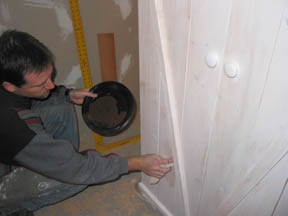
Wipe on the accent stain. Notice the small corporeality of stain on the plate.
Tip: Test out the accent stain in an camouflaged location beginning – either on chip lumber or somewhere unseen. I tested it on the underside of one of the shelves before proceeding to utilize it on the whole pantry.
Apply one more coat of varnish one time this accent stain has stale.
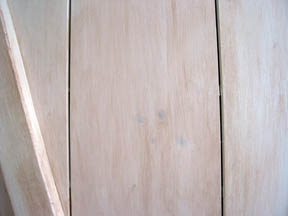
Close up of emphasis stain.
You are now finished with your stop.
May 17, 2012
We stayed in a cabin last winter that had the logs and furniture pickled. Very absurd. I took some pictures with my telephone. Not the best quality but you get the thought.
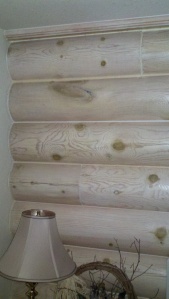
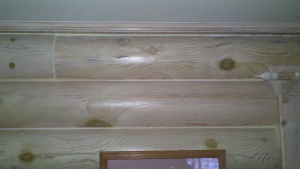

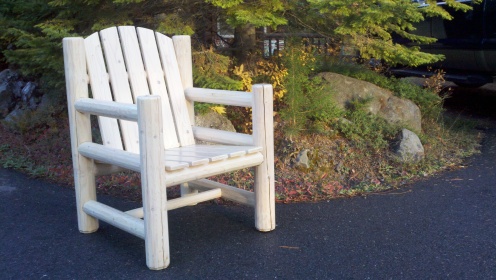
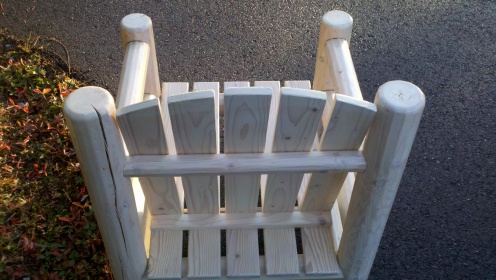
Source: https://woodplay.wordpress.com/2009/01/02/a-no-hassle-technique-to-pickle-wood/
Posted by: cavendercoluseld.blogspot.com


0 Response to "How To Pickle Paint And Mix Paint"
Post a Comment